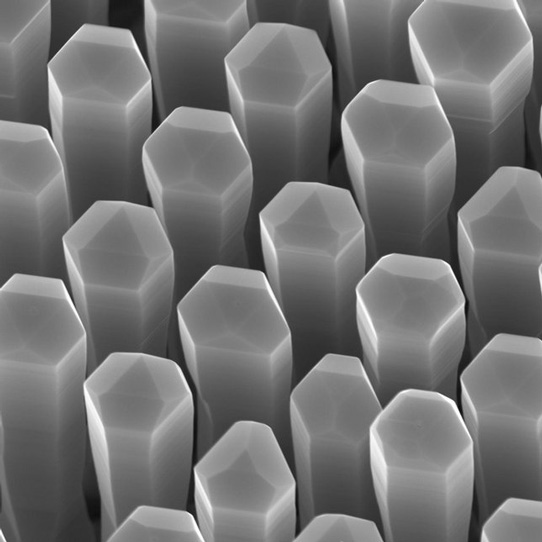News: Optoelectronics
10 April 2020
Direct-bandgap emission achieved from hexagonal Ge and SiGe alloys
For the past 50 years, researchers worldwide have been looking for a way to fabricate silicon- or germanium-based lasers. A team at the Technical University of Eindhoven (TU/e) and the Technical University of Munich (TUM), together with colleagues at the universities in Jena and Linz, has now developed a light-emitting silicon-germanium alloy that can emit light (E.M.T. Fadaly et al, ‘Direct Bandgap Emission from Hexagonal Ge and SiGe Alloys’, Nature, 8. April 2020; DOI: 10.1038/s41586-020-2150-y). As a result, the development of a silicon laser capable of integration into existing chips is within reach for the first time, it is reckoned.
Silicon normally crystallizes in a cubic crystal lattice, and in this form it is not suitable for converting electrons into light, due to having an indirect bangap. The crucial step made by the research team was the ability to produce germanium and alloys from germanium and silicon with a hexagonal crystal lattice. “This material has a direct bandgap, and can therefore emit light itself,” says Jonathan Finley, Professor of Semiconductor Quantum Nanosystems at TUM.
The template trick
Professor Erik Bakkers and his team at TU/e first produced hexagonal silicon in 2015. They started by growing a hexagonal crystal structure with nanowires made of another material. This served as a template for a germanium-silicon shell on which the underlying material imposed its hexagonal crystal structure.

Picture: Nanowires with hexagonal SiGe shells.
Initially, however, these structures could not be stimulated to emit light. Through exchanging ideas with colleagues at the Walter Schottky Institute at the Technical University of Munich, who analyzed the optical characteristics with each successive generation, the production process was finally optimized so that the nanowires were capable of emitting light.
“In the meantime, we have achieved properties almost comparable to indium phosphide or gallium arsenide,” says Bakkers. As a result, it appears to be just a matter of time before a laser made from germanium-silicon alloys and capable of integration into conventional production processes is developed, it is believed.
“If we can implement on-chip and inter-chip electronic communications by optical means, speeds can be increased by a factor of up to 1000,” says Finley. “In addition, the direct combination of optics and electronics could drastically reduce the cost of chips for laser-based radar in self-driving cars, chemical sensors for medical diagnostics, and air and food quality measurements.”
The research project received funding from European Union (EU) project SiLAS, the Marie Sklodowska Curie Programme of the EU, the Dutch Research Council (NWO), the Solliance Initiative of the Energy research Centre of the Netherlands (ECN), the Holst Center, the TU/e, the Netherlands Organization for Applied Scientific Research (TNO), the Interuniversity Microelectronics Centre (IMEC), the Forschungszentrum Jülich and the province of North Brabant in the Netherlands. The Deutsches Elektronen Synchrotron (DESY) in Hamburg provided measurement time on the PETRA III facility. Theoretical calculations were carried out on the SuperMUC high-performance computer at the Leibniz Supercomputing Center in Garching, Germany.
www.nature.com/articles/s41586-020-2150-y









